Multi-scale variability of the tropical Indian Ocean circulation system revealed by recent observations
Ke HUANG1'4, Dongxiao WANG1, Weiqiang WANG1'3, Qiang XIE1'2'3, Ju CHEN1,
Lingfang CHEN2 & Gengxin CHEN1*
1State Key Laboratory of Tropical Oceanography, South China Sea Institute of Oceanology, Chinese Academy of Sciences,
Guangzhou 510301, China;
2Institute of Deep Sea Science and Engineering, Chinese Academy of Sciences, Sanya 572000, China;
3Laboratory for Regional Oceanography and Numerical Modeling, Qingdao National Laboratory for Marine Science and
Technology, Qingdao 266237, China;
4State Key Laboratory of Marine Environmental Science, Xiamen University, Xiamen 361005, China
Received September 9, 2017; revised October 26, 2017; accepted February 9, 2018; published online April 3, 2018
Abstract
The tropical Indian Ocean circulation system includes the equatorial and near-equatorial circulations, the marginal sea circulation, and eddies. The dynamic processes of these circulation systems show significant multi-scale variability associated with the Indian Monsoon and the Indian Ocean dipole. This paper summarizes the research progress over recent years on the tropical Indian Ocean circulation system based on the large-scale hydrological observations and numerical simulations by the South China Sea Institute of Oceanology (SCSIO), Chinese Academy of Sciences. Results show that: (1)the wind-driven Kelvin and Rossby waves and eastern boundary-reflected Rossby waves regulate the formation and evolution of the Equatorial Undercurrent and the Equatorial Intermediate Current; (2) the equatorial wind-driven dynamics are the main factor controlling the inter-annual variability of the thermocline in the eastern Indian Ocean upwelling; (3) the equatorial waves transport large amounts of energy into the Bay ofBengal in forms of coastal Kelvin and reflected free Rossby waves. Several unresolved issues within the tropical Indian Ocean are discussed: (i) the potential effects of the momentum balance and the basin resonance on the variability of the equatorial circulation system, and (ii) the potential contribution of wind-driven dynamics to the life cycle of the eastern Indian Ocean upwelling. This paper also briefly introduces the international Indian Ocean investigation project of the SCSIO, which will advance the study of the multi-scale variability of the tropical Indian Ocean circulation system, and provide a theoretical and data basis to support marine environmental security for the countries around the Maritime Silk Road.
Keywords Equatorial undercurrent, Equatorial intermediate current, Eastern Indian Ocean upwelling, Bay of Bengal circulation, Multi-scale variability, Equatorial wave dynamics, Observation and simulation
Citation: Huang K, Wang D, Wang W, Xie Q, Chen J, Chen L, Chen G. 2018. Multi-scale variability of the tropical Indian Ocean circulation system revealed by recent observations. Science China Earth Sciences, 61: 668-680, https://doi.org/10.1007/s11430-017-9179-x
1. Introduction
The tropical Indian Ocean circulation system has unique dynamic characteristics and a complex circulation structure that induce strong heat and volume transport variations,Corresponding author (email: chengengxin@scsio.ac.cn)
which influence the regional energy balance and global climate change (Schott and McCreary, 2001; Schott et al., 2009). Recent studies have found that the tropical Indian Ocean circulation system is not just confined to monsoonal variability, but also possesses inter-annual variability and coupled processes associated with the Indian Ocean Dipole (IOD) and El Nino-Southern Oscillation (ENSO) (Saji et al.,1999; Webster et al., 1999; Schott et al., 2009). Observed and simulated results indicate that the multi-scale variability of the tropical Indian Ocean circulation system can affect the global ocean circulation system and climate change through basin wave dynamics and air-sea thermodynamics (Wang et al., 1999; Thompson et al., 2006; Godfrey et al., 2007; Wang and Yuan, 2015).
The dynamic adjustment of the tropical Indian Ocean circulation system and its multi-scale variability are of considerable research interest. Previous studies have shown that the sea surface wind sets up the tropical Indian Ocean circulation system. Affected by the Indian Monsoon, the winds over the tropical Indian Ocean have pronounced an- nual and semiannual variability (Ogata and Xie, 2011). However, the equatorial Indian Ocean circulation system has significant semiannual variability only, due to the semi- annual resonance and the spatial counteraction of the annual response (Han et al., 1999). The surface current in the equatorial Indian Ocean is a strong jet (Wyrtki Jets, WJs) (Wyrtki, 1973) that occurs every six months during the monsoon transition. Wyrtki (1973) suggested that the WJs are directly controlled by the equatorial westerlies during the monsoon transition. Results from a two-layer model showed that, under the direct forcing of the equatorial westerlies, the model forms a strong surface jet that propagates eastward (O’Brien and Hurlburt, 1974). Other simulation results have shown that the intensity of the WJs is highly sensitive to the change in the surface wind in the equatorial Indian Ocean (Anderson and Carrington, 1993; Han et al., 1999). Nagura and McPhaden (2016) concluded that the WJs are controlled by the equatorial waves associated with the zonal phase propagation of the equatorial wind, and its zonal phase spreads westward in spring and eastward in autumn. Duan et al. (2016) suggested that the anomalous variations of the WJs are also modulated by a strong intraseasonal oscillation. McPhaden et al. (2015) demonstrated that the anomalous equatorial easterly associated with a positive IOD event weakens the WJs in autumn, whereas the anomalous equa- torial westerly associated with a negative IOD strengthens the WJs. The heat and mass balances of the WJs within the multi-scale variability have an extremely important influence on the marine environment and extreme weather events in the tropical Indian Ocean (Masson et al., 2004; Schott et al., 2009).
The pressure gradient that is induced by the equatorial winds in the Indian Ocean can drive an important equatorial undercurrent (EUC) over the thermocline layer. Previous studies have shown that the EUC is characterized by tran- sient equatorial wave dynamics, which display significant semiannual variability and occur in different regions and months in the equatorial Indian Ocean (Swallow, 1967; Schott et al., 1997; Reppin et al., 1999; Iskandar et al., 2009). However, the EUC has disappeared during several years,such as 1974 and 2003 (Reppin et al., 1999; Knox, 1976; Iskandar et al., 2009). The EUC also experiences significant inter-annual variability. During a positive IOD event, the EUC forms over August and lasts until December (Han et al., 2004). Swapna and Krishnan (2008) and Krishnan and Swapna (2009) demonstrated that the strengthened summer monsoon associated with positive IOD events produces an anomalous nonlinear amplification effect south of the Equator, enhancing the eastern Indian Ocean upwelling and shallowing the thermocline, causing the zonal pressure gra- dient to enhance the EUC. The multi-scale variability of the EUC illustrates the heat and mass transport that occurs in the subsurface channel of the equatorial Indian Ocean, which is also of great importance for climate change.
Eastern Indian Ocean upwelling occurs in the southeastern tropical Indian Ocean, induced by the Ekman effect of the southeast monsoon, and plays an important role in the local ecosystem and fisheries. Previous studies have found that, although the local winds are the primary cause of the up- welling (Susanto et al., 2001), the Kelvin wave induced by the equatorial wind during the monsoon transition is also an important factor (Arief and Murray, 1996; Clarke and Liu, 1993; Sprintall et al., 2000). Kuswardani (2012) used the maximum vertical velocity to define the intensity of the eastern Indian Ocean upwelling and found that the upwelling intensity based on this index is controlled by IOD events, showing significant inter-annual variability.
The Bay of Bengal is closely linked to the eastern tropical Indian Ocean warm pool, where the most striking feature is the frequent occurrence of mesoscale eddies. This eddy transport helps modulate the marine environment of the bay. Sanilkumar et al. (1997) and Babu et al. (2003) found that the instability of the basin circulation system caused by the variability of local wind is the main cause of the frequent mesoscale eddies in the bay. Yu et al. (1991) used a reduced gravity model to demonstrate that equatorial remote forcing is also one of the most important factors in the circulation and eddy variability over the Bay of Bengal.
The tropical Indian Ocean circulation system is a complex dynamic system. However, because of the lack of observa- tions, the dynamic and internal relations of this system re- main elusive, including the formation mechanism of the Equatorial Intermediate Current (EIC) and its relationship with the EUC, how the eastern Indian Ocean upwelling is related to the variability of the EUC, and how the circulation of the southern Bay of Bengal is affected by the remote equatorial forcing dynamics. Based on the large-scale hy- drographic observations and ocean circulation simulations in the tropical Indian Ocean carried out by the South China Sea Institute of Oceanology (SCSIO), Chinese Academy of Sciences (CAS), this paper systematically summarizes the recent progress in the multi-scale variability and mechanisms of the tropical Indian Ocean circulation system in response to equatorial wind forcing. The scientific planning of the Sec- ond International Indian Ocean Expedition (IIOE2) is also discussed.
2.Data and methods
2.1Observation
Four moorings (Q2, Q3, Q4, and Q5), each containing an upward-looking Acoustic Doppler Current Profiler (ADCP), were deployed by the SCSIO. Q2, Q3 Q4, and Q5 were located at (0 , 93 E), (5 N, 90.5 E), (0 , 85 E), and (0 ,80 E), respectively, and provided data from March 2015 to March 2016 (Figure 1; Table 1). The equatorial moorings (Q2, Q4, and Q5) were used to observe the equatorial cir- culation system, and Q3 in the southern Bay of Bengal was used to observe the near-equatorial oceanic phenomena.
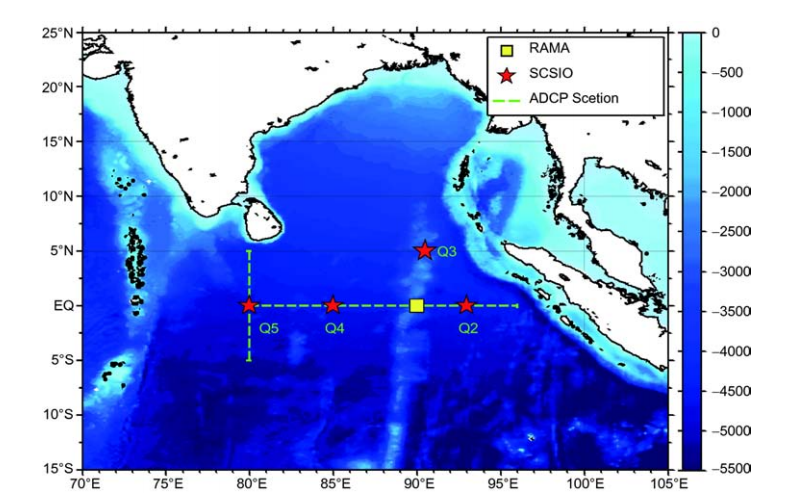
Figure 1 Map of the mooring observations in the tropical eastern Indian Ocean. The stars indicate the moorings deployed by the SCSIO, and the square is the RAMA mooring. The green line represents the selected section.
The current measurements obtained from the mooring of the Research Moored Array for African-Asian-Australian Monsoon Analysis and Prediction (RAMA) (McPhaden et al., 2009) were analyzed to verify the reanalysis and model outputs. The mooring was located at (0 , 90 E) from No- vember 2000 to June 2012 (Figure 1).
2.2Reanalysis data
Monthly current data from the European Centre for Medium- Range Weather Forecasts-Ocean Reanalysis System 4 (ORAS4) (Balmaseda et al., 2013), from 2001 to 2015, were used to analyze the 3D structures of the sub-thermocline zonal current in the Indian Ocean. ORAS4 is constructed byassimilating various historical observations into the ocean model with a horizontal resolution of 1 1 and 42 vertical levels.
The high resolution wind reanalysis dataset (NCEP Cli- mate Forecast System Reanalysis, CFSR) was used to cal- culate the wind-driven upwelling index in the eastern Indian Ocean. The interval of NCEP-CFSR is 6 hours, from 1980 to 2014, and the spatial resolution is 0.3 0.3 .
2.3Simulation
In order to study the dynamics of the equatorial Indian Ocean circulation, a new version of the Hybrid Coordinate Ocean Model (HYCOM), that containing a complete set of dynamic equations, was first used to simulate the evolution of the equatorial circulation and its relationship with surface wind forceing. The simulated area is between 50 S~30 N, 30 E~ 122.5 E, with the horizontal resolution of 0.25 latitude 0.25 longitude. Vertically the model is divided into 26 layers. The detailed settings of the HYCOM can be seen Li et al. (2014).
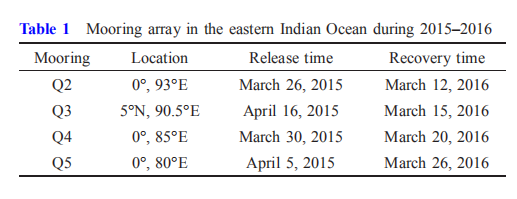
This study further used the Linear Ocean Model (LOM) to investigate the contributions of wind-driven equatorial dy- namics on the evolution of the tropical circulation. The de- tails of LOM can be found in McCreary (1980, 1981) and LOM was applied to explain the East Indian Ocean coastal currents, east boundary reflections, and ocean basin re- sonances (Shankar et al., 1996; Yuan and Han, 2006; Han et al., 2011). Here the LOM is driven by a daily wind field named the Cross-Calibrated Multi-Platform (CCMP). The model was spin up with 20-year, and then forward integra-tion to obtain the monthly current and pressure fields from 1988 to 2011.
2.4WKB equatorial beam theory
For frequencies that are everywhere small compared with buoyancy frequency, the hydrostatic approximation applies and the relationship between buoyancy frequency Nb and wavenumber m given as WKB approximation (Gill, 1982):

thereby transforming (1) into the dimensional dispersion relation of the linear equatorial waves:

where, is the frequency (e.g., =4 year?1 for semi-annual variability), m is the vertical wavenumber, and k is the zonal wavenumber. The meridional mode number is n.Within the limit of the low-frequency long zonal waves, where k 2 0 and 2 0, the dispersion relation becomes

The waves described by the dispersion relation are the equatorial Kelvin wave for n=?1 and the long equatorial Rossby waves for n=1, 2, 3, … . The zonal and vertical phase velocities are

and the group velocities are

Zonal propagation within this limit is non-dispersive. The vertical phase and group velocities are equal in magnitude, but opposite in sign. Thus, the observed upward propagation of phase implies downward propagation of energy.
The usual ray equations give the slope of the ray paths in the (x, z) plane as:

According to eq. (8), the phase propagates upward across a band of energy propagating downward to the west (energy originates at the surface and propagates downward to the west), with a steeper slope for weaker stratification or a higher meridional mode number n. Phase propagation in the zonal and vertical directions is, by definition, /k and /m.
Therefore, the lines of constant phase have the slope

because zonal propagation is non-dispersive, the slope has the same value as the slope of ray paths. Therefore, the phase lines are parallel to the ray paths (Philander, 1978; Eriksen, 1981; Luyten and Roemmich, 1982; Lukas and Firing, 1985; Kessler and McCreary, 1993).
3.Multi-scale variability of the tropical Indian Ocean circulation system and their connection
The multi-scale variability and mechanisms of the tropical Indian Ocean circulation system are the focus of recent In-dian Ocean environmental research (namely, IIOE2; Hood etal., 2015). The equatorial wind-driven wave dynamics have stimulated a unique equatorial circulation system with pro- nounced seasonal features. As the wind-driven wave pro- pagates eastward along the Equator, and southward and northward along the coastal boundary, the equatorial dy- namics have a significant impact on eastern Indian Ocean upwelling, the circulation, and the eddies in the Bay of Bengal. Based on the observations of the SCSIO, we de- scribe in this section the features and mechanisms of the EUC and EIC in the Indian Ocean, and identify the under- lying mechanism of the multi-scale variability of the Eastern Indian Ocean upwelling, as well as the impact of the equa- torial wave dynamics on the circulation and eddies in the Bay of Bengal.
3.1Features and mechanisms of the EUC and EIC in the Indian Ocean
Based on observations and simulations by the Hybrid Co- ordinate Ocean Model (HYCOM) and linear ocean model (LOM), Chen et al. (2015a) described the features and un- derlying mechanism of the transient EUC in the Indian Ocean and proposed a new view that the EUC still exists in summer and autumn without being affected by the intensity of the Indian Monsoon. The main structure of the EUC was located in the depth range of 60–200 m, and its core was located near the 20 C isotherm with a magnitude range of 50–60 cm s?1 and a maximum of 120 cm s?1. It appeared in the spring and winter from February to April (winter-springEUC), and reappeared in summer and autumn from Augustto October (summer-autumn EUC), while its intensity wassignificantly weakened during this period. The EUC was mainly caused by the equatorial Kelvin and Rossby waves that were directly forced by the equatorial wind in the wes- tern Indian Ocean, while the equatorial long Rossby waves reflected from the eastern boundary played an important role in the eastern Indian Ocean (Chen et al., 2015a). The winter- spring EUC could penetrate the whole basin of the equatorial Indian Ocean. However, the summer-autumn EUC usually occurred in the western Indian Ocean and appeared in the eastern Indian Ocean only during positive IOD events. The westward pressure gradient induced by the anomalous equatorial westerlies during negative IOD events and non- IOD events induced western subsurface currents in the eastern Indian Ocean, resulting in the disappearance of the EUC in the eastern Indian Ocean.
The mooring observations from the SCSIO have further demonstrated the evolution of the EUC over recent years, capturing new features such as the westward phase propa- gation of the EUC (Figure 2). In addition, the moorings have also revealed the unique features of the EIC (defined for 200–1200 m depths) with significant upward and westward phase propagation. The lag correlation coefficient of the EIC reached a maximum of 0.50 between Q2 and Q4 with a 22- day lag, and a maximum of 0.82 between Q4 and Q5 with a 10-day lag. The observed westward propagation velocities were 46.3 and 63.7 cm s?1, respectively, which were close to
the phase velocity of the first meridional mode Rossby wave. The observed EIC in the Pacific and Atlantic oceans has been shown to exhibit a strong annual cycle and phase propaga- tion, dominated by the Rossby waves reflected from the eastern boundary (Delcroix and Henin, 1988; Firing, 1987; Kessler and McCreary, 1993; Fischer and Schott, 1997; Gouriou et al., 2006). The observed EIC in the Indian Ocean, meanwhile, has pronounced semiannual variability (Luyten and Roemmich, 1982); however, the underlying mechanisms of EIC phase propagation remain unclear.
The ORAS4 reanalysis data is further used to understand the mechanisms of EIC phase propagation in the Indian Ocean. Figure 3 presents zonal current comparisons between ORAS4 and the moored observations. There is reasonable agreement between the observed records and the reanalysis output from 2001 to 2012, and from 2015 to 2016. Figure 4 shows the comparisons of zonal flows along 80 E and equatorial sections. The good agreement increases our con- fidence in the ability of ORAS4 to reproduce the large-scale variability of the EIC. Based on linear equatorial wave beam theory, upward phase propagation indicates downward en- ergy propagation (Philander, 1978). To study the relationship between EIC phase propagation and the equatorial energy beams, we used complex empirical orthogonal function de- composition (C-EOF) (Wei, 2002) to isolate the dominant patterns of variability that propagate in time and space. The

Figure 2 Time-depth maps of the daily zonal current obtained from equatorial moorings. (a) Q2 at 0 , 93 E; (b) Q4 at 0 , 85 E; (c) Q5 at 0 , 80 E. Red dotted lines indicate the depth of the EUC (60–140 m). Blue lines denote the depth of the EIC (200–500 m). The zonal current has been filtered with a 30-day low-pass filter.
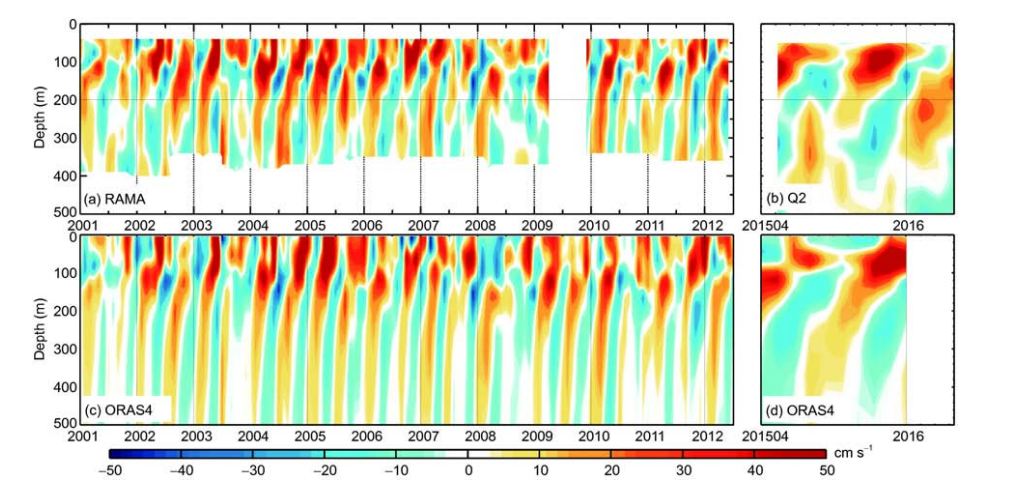
Figure 3 Time-depth maps of the monthly zonal current. (a) and (c), RAMA and ORAS4 at 0 , 90 E; (b) and (d), Q2 and ORAS4 at 0 , 93 E.
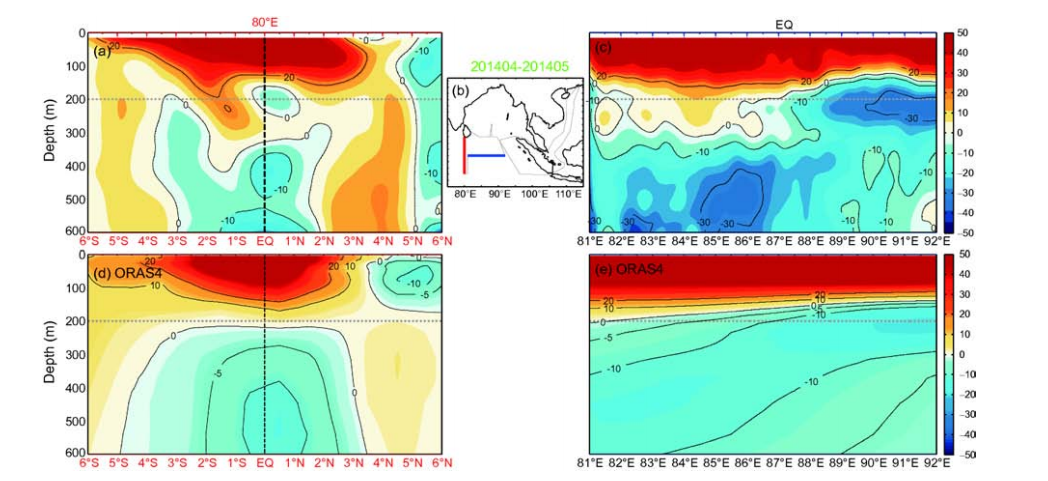
Figure 4 Spatial distribution of zonal flow at 80 E and equatorial section from April to May in 2014 obtained from ADCP observations and ORAS4. (a) and (c) for cruise ADCP observations; (d) and (e) for ORAS4 reanalysis. The red line is the 80 E section and the blue line is the equatorial section in (b).
principal component (PC) and spatial patterns (real and imaginary parts) of the first C-EOF mode were calculated in the depth range of 50–1200 m to exclude the strongly en- ergetic surface currents. This mode explains 60.1% of the total variance with a prominent semiannual cycle (Figures 5a and 4b). The spatial amplitude and phase obtained from the real and imaginary spaces of the 1st C-EOF are presented in Figure 6. The dominant structures in the spatial amplitude and phase of the 1st C-EOF are given by a shallow, eastward and downward Kelvin beam, and deep, westward anddownward Rossby beams. The slope of the spatial phase propagation of the EIC was parallel to the slope of the first meridional Rossby beam, which indicated that the vertical propagation of the EIC was controlled by the first meridional Rossby waves.
We also used C-EOF decomposition to analyze the zonal current along an 80 E section and examine the features of the meridional structure (Figure 7). The upward phase propa- gation features significant semiannual variability trapped within 2.5 S–2.5 N near the Equator, indicating that the lowest meridional mode plays a major role in controlling the features of the EIC. During EIC phase propagation in the Indian Ocean, the semiannual Kelvin wave induced by the equatorial surface wind propagates energy eastward and downward along the Kelvin beam (Figure 7a), reaches the eastern boundary, and reflects into the semiannual Rossby waves, which propagates energy downward and westward along the Rossby beams. In addition, the principal compo- nent of C-EOF presents a significant anomalous value from late 2006 to early 2007, with a weakening of the semiannual variability (Figure 5a). This indicates that the enhanced equatorial annual wind accompanying the positive IOD event in 2006 disrupted the structure of the semiannual variability of the EIC.
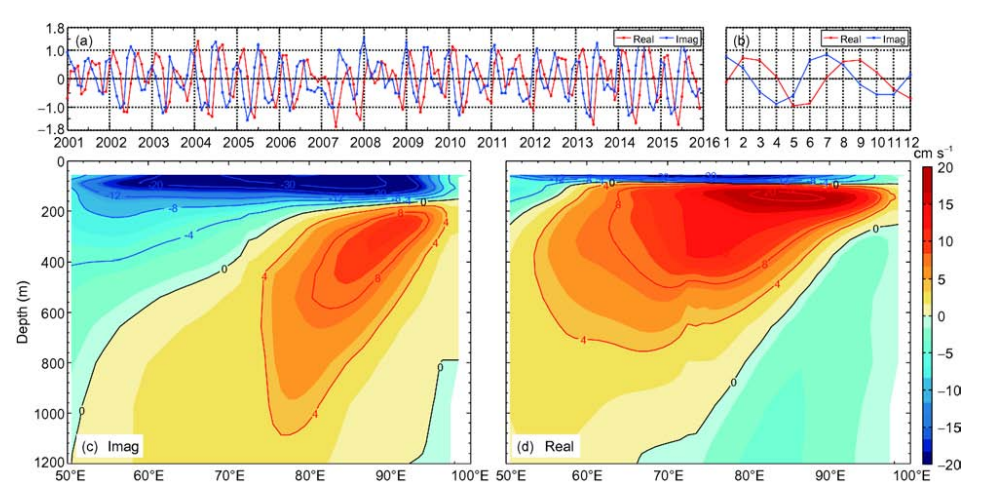
Figure 5 Principal component and spatial distribution of the 1st C-EOF of the equatorial zonal current. (a) Time series of the principal component (the red line is the real part and blue is the imaginary part). (b) Annual cycle of the climatological principal component series. Spatial distribution of the (c) imaginary and the (d) real parts of C-EOF.

Figure 6 The (a) spatial amplitude and (b) spatial phase of the 1st C-EOF decomposition obtained from the monthly zonal velocities along the Equator. The Wentzel-Kramers-Brillouin (WKB) theoretical ray paths are shown: wind generated Kelvin (green dashed lines) and reflected Rossby rays of the first (red solid lines) and second (red dashed lines) meridional mode
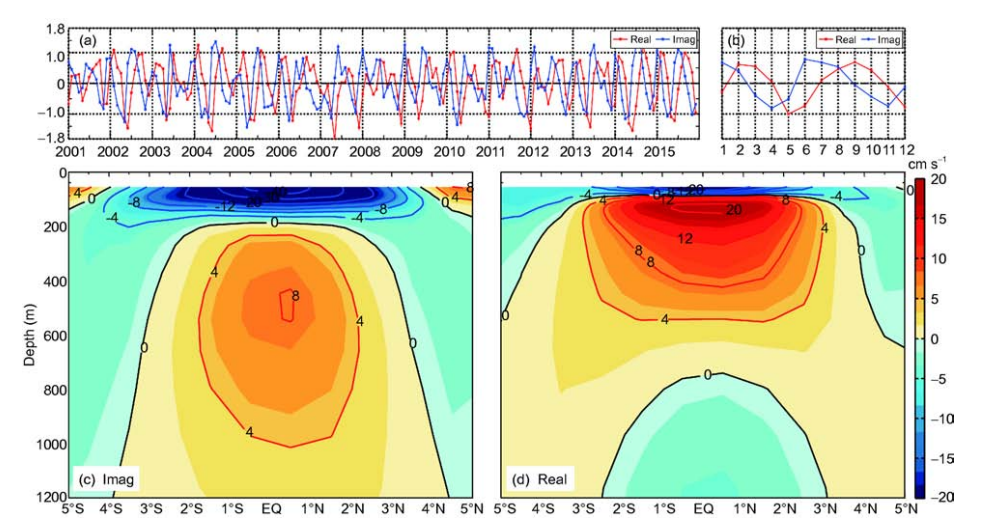
Figure 7 Principal component and spatial distribution of the 1st C-EOF of the zonal current along 80 E section. (a) Time series of the principal component (the red line is the real part and blue is the imaginary part). (b) Annual cycle of the climatological principal component series. Spatial distribution of the (c) imaginary and the (d) real parts of C-EOF.
3.2Features and mechanism of the eastern Indian Ocean upwelling
Previous studies have found that the eastern Indian Ocean upwelling is mainly regulated by local wind and remote forcing; however, their relative importance is not clear. Based on remote sensing observations, reanalysis data, and a series of HYCOM ocean-model experiments, Chen et al. (2015b, 2016a) analyzed the multi-scale variability and mechanisms of the eastern Indian Ocean upwelling in the warm pool. The intra-seasonal and inter-annual variability of the thermocline in the upwelling region was mainly con- trolled by the remote forcing of the equatorial Indian Ocean wind. The equatorial wind excited the downwelling andupwelling Kelvin waves to propagate along the Sumatra- Java coast, which controlled the multi-scale variability of the thermocline in the upwelling region. However, different mechanisms controlled the seasonal variability of the SST in the upwelling region. During summer and autumn, the intra- seasonal/inter-annual variability of SST was directly con- trolled by the variability of the thermocline, and was sig- nificantly affected by the equatorial wind-driven dynamic. During winter and spring, however, with a deep seasonal thermocline, the SST was mainly unaffected by the ther- mocline, and its variability was controlled by the local heat flux and entrainment.
Different from the quasi-constant eastern equatorial up- welling and EUC in the Pacific and Atlantic oceans, the EUC in the Indian Ocean and the eastern equatorial upwelling are characterized by seasonal and transient variability, while the relationship between them is unknown. Chen et al. (2016b) found that the EUC in the Indian Ocean provided a source of water for the upwelling through a buffering process. During winter and spring, the EUC transported saltwater into the eastern Indian Ocean, which then subducted. After several months, the saltwater entered the thermocline and mixed layer through upwelling, providing a source of water for the upwelling. During positive IOD events, the enhanced EUC in summer and autumn will provide additional water sources for the enhanced upwelling.
By defining an upwelling index via the wind-induced Ekman transport, we studied the features of upwelling, in- cluding the start time (STI) and the end time (END). Based
on this wind-induced dynamic index, established using CFSR reanalysis data (Cumulative Upwelling Index, CUI) (Bograd et al., 2009), we examined the evolution of the STI, END, and the strongest period (MAX) of the eastern Indian Ocean upwelling. It was found that the CUI can describe the life cycle of the upwelling and its intensity. Figure 8 presents the features of the Ekman transport obtained from the coastal winds. Positive Ekman transport occurred mainly from 102 E to 120 E along the Java coast (Figure 8b), beginning ap- proximately in April and reaching a maximum in summer. We calculated the accumulated Ekman transport to obtain the CUI index, and Figure 9 presents the time series of the CUI obtained from the red star in Figure 8a. The STI of the up- welling occurred between the 80th and 90th days and the END occurred between the 330th and 350th days, which indicates that the duration of upwelling was 252, 255, and 250 days, respectively. The MAX was characterized as late on the western coast and early on the eastern coast. We further examined the inter-annual variability of STI, END, and MAX (Figure 10). The results show significant inter- annual variability, especially for MAX and END, which may be associated with the IOD/ENSO-related wind pattern (si- milar to the findings of Susanto et al., 2001).
3.3Circulation and vertexes in the Bay of Bengal
The equatorial Indian Ocean transports large amounts of energy into the Bay of Bengal via the coastal Kelvin and reflected free Rossby waves, which has a significant impact on the circulation and eddies in the bay. Observations from mooring Q3 indicate that a strong meridional current (~0.4 m s?1) occurs in the 5 N section of the southern Bay of Bengal (Chen et al., 2017). This meridional current has a north- and southward alternation with significant in-traseasonal variability (30–50 days). Numerical simulations from HYCOM indicate that this strong current is mainly driven by the intraseasonal variability of the equatorial wind. The wind-driven Kelvin wave along the Equator reached the eastern boundary, and was first trapped along the coast be- fore then being reflected from the northwest corner of Su- matra as Rossby waves to form an eddy-like structure propagating westward along 5 N. This resulted in the evo- lution of the strong meridional current. Further studies have indicated that this strong meridional current occurs in the near-equatorial region of the eastern Indian Ocean, and in the eastern Pacific and Atlantic oceans.
The equatorial waves affect the circulation in the near- equatorial region, including the southern Bay of Bengal, and contribute significantly to the interior circulation and eddies in the bay. Studies have shown that eddies in the western Bay of Bengal gain energy from the background circulation through the barotropic and baroclinic instabilities. Different from the western basin, the barotropic and baroclinic in- stabilities of the background circulation are weak in the eastern basin. However, there are also a large number of mesoscale eddies in this region (Chen et al., 2012). Cheng et al. (2017) demonstrated that the formation of eddies in the eastern Bay of Bengal are greatly affected by the equatorial wave dynamics, but this process still requires further in- vestigation.
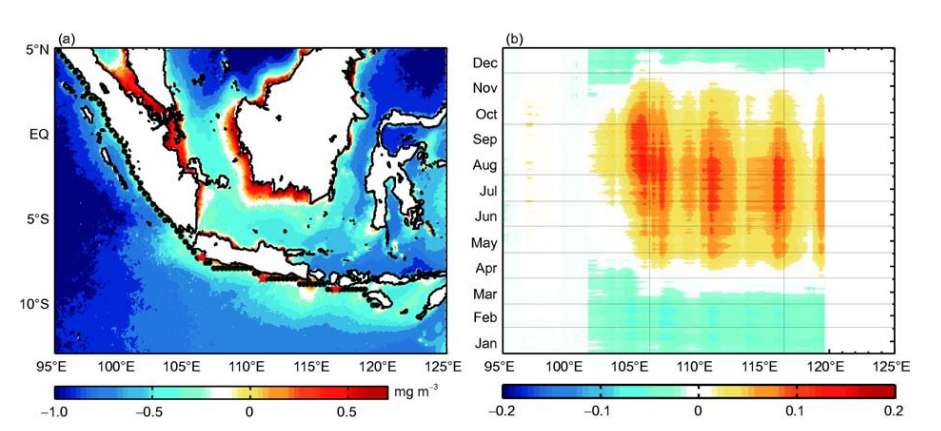
Figure 8 (a) Spatial structure of the climatological chlorophyll-a concentration and the calculated locations of the Ekman transport along the Sumatra-Java coast. (b) Time (month)-longitude map of the Ekman transport index along the Sumatra-Java coast. Positive values indicate off-coast transport.
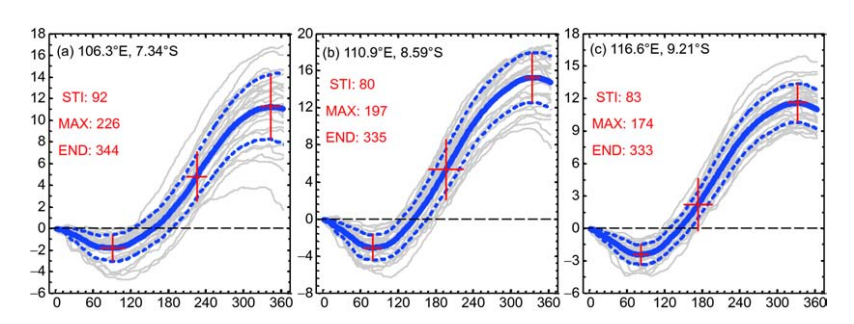
Figure 9 Cumulative Upwelling Index (CUI) for three locations along the Sumatra-Java coast. The mean and standard deviation (black solid and dashed curves, respectively) for 1980–2014 (gray curves) are shown. Julian days (red text) of the climatological start (top) and end (bottom) of the upwelling season and maximum upwelling (middle) are shown for each location. Standard error ellipses for CUI and the Julian day of the start, end, and maximum upwelling are shown in red. (a) (7.34 S, 106.3 E); (b) (8.59 S, 110.9 E); (c) (9.21 S, 116.6 E).

Figure 9 Cumulative Upwelling Index (CUI) for three locations along the Sumatra-Java coast. The mean and standard deviation (black solid and dashed curves, respectively) for 1980–2014 (gray curves) are shown. Julian days (red text) of the climatological start (top) and end (bottom) of the upwelling season and maximum upwelling (middle) are shown for each location. Standard error ellipses for CUI and the Julian day of the start, end, and maximum upwelling are shown in red. (a) (7.34 S, 106.3 E); (b) (8.59 S, 110.9 E); (c) (9.21 S, 116.6 E).
3.4 Unresolved issues
Although observations and simulations by the SCSIO have made progress in understanding the features and mechanisms of the tropical Indian Ocean circulation system, there are still many unresolved issues. Philander and Chao (1991) de- monstrated that the reason for the different evolution of the EUC between the Pacific and Atlantic oceans is the differ- ence in the momentum balance of the subsurface pressure gradient in response to the different wind forcing. The transient EUC in the Indian Ocean indicates that there is a clear and different momentum balance compared with that in other oceans, and that the detailed dynamics still require further study. In addition, Brandt et al. (2016) found that the features of volumetric transport, current core, and maximum velocity of the EUC in the Atlantic Ocean can be controlled with basin resonance. However, the importance of the equatorial basin resonance on semiannual time scales in shaping the features of the EUC and EIC in the Indian Ocean are still unclear. Furthermore, the intrinsic dynamic links of the equatorial circulation system require further attention. Previous studies have applied particle tracer methods to study the circulation in the southern Indian Ocean, the In- donesian Throughflow, and the South China Sea deep cir- culation (Valsala et al., 2010; Shu et al., 2014); however, the material and energy exchange among the WJs, the EUC and EIC in the equatorial Indian Ocean, and their dynamic links, are still unclear and have not yet been dynamically in- vestigated.
Although the impact of the equatorial wind-driven dy- namics on the multi-scale variability of the eastern Indian Ocean upwelling has been systematically studied, many questions remain. For instance, how is the life cycle of the upwelling in the eastern Indian Ocean regulated by local and remote wind forcing, and how are the water exchange and volume balance of the upwelling associated with the varia- bility of the EIC? In addition, the dynamics of the wind- induced downwelling in the eastern Indian Ocean and the possible links with the equatorial wind-driven dynamic re- main unclear.Observations have demonstrated the significant impact of the equatorial wind-driven dynamics on the evolution of the circulation and eddies in the Bay of Bengal. However, against the background of inter-annual variability over the tropical Indian Ocean (e.g., the IOD/ENSO), important fu- ture topics include how the inter-annual variability of the circulation and eddies in the Bay of Bengal relate to the equatorial wind-driven dynamics and their physical me- chanisms.
4.Conclusion and outlook
IIOE-2 is a current major international scientific project aimed at studying the marine environment of the Indian Ocean. The goals of IIOE-2 are to promote understanding of the Indian Ocean circulation and its role in the earth system, and to support the sustainable development of human beings along the Indian Ocean. Studying the features of the tropical Indian Ocean circulation system and its relationship with the multi-scale variability of the atmospheric forcing help to understand and predict the impact of extreme weather, the variability of the Indian Ocean warm pool, the IOD, and coastal drought and flood disasters, fulfilling the set goals of IIOE-2. However, the complex features of the tropical ocean circulation system make studying the Indian Ocean chal- lenging. Based on the long-term observation systems de- ployed in the tropical Indian Ocean by the SCSIO, this paper summarizes the multi-scale variability of the tropical Indian Ocean circulation systems, as well as their connections and underlying mechanisms.
(1)The generation of the EUC and EIC in the Indian Ocean are the result of the combined effects of the wind- driven Kelvin and Rossby waves, and the Rossby waves reflected from the eastern ocean boundary. The EUC is characterized by transient and strong semiannual variability. The formation mechanism of the EUC in the eastern basin is different from that in the western basin, and the abnormal IOD-related equatorial wind forcing has a significant impact on the EUC transient pattern. Linear equatorial wave theory can be used to explain the evolution of the EIC based on moored observations. The Kelvin wave excited by the equatorial wind forcing propagates energy eastward and downward, and the reflected Rossby waves associated with the Kelvin wave in the equatorial eastern boundary propa- gate energy westward and downward along the equatorial beam, compared with the westward and upward phase pro- pagation.
(2)In the equatorial wind-driven dynamics of the multi- scale variability of the eastern Indian Ocean upwelling, the equatorial wind induces downwelling and upwelling Kelvin waves that reach the eastern boundary and propagate along the coast into the Sumatra-Java seas to modulate the multi- scale variability of the thermocline in the upwelling region. The EUC in the Indian Ocean provides a source of water for the evolution of the eastern Indian Ocean upwelling through a buffering process. In addition, the life cycle of the up- welling (i.e., start and end times, and intensity) occurs late on the western coast and early on the eastern coast along the Sumatera-Java coastline.
(3)In the equatorial wind-driven dynamics of the circu- lation and eddies in the Bay of Bengal, the equatorial wind- driven waves transport large amounts of energy into the Bay of Bengal in the form of coastal Kelvin waves and reflectedfree Rossby waves, and regulate the evolution of the circu- lation and eddies in this region.
It is expected that, along with the advancement of IIOE-2, international competition will take place in the future in the multi-scale variability of the tropical Indian Ocean circula- tion and its dynamics. Faced with the situation in Indian Ocean circulation research, we should continue to produce more observations from the Indian Ocean and make a greater contribution to understand the environmental change in the Indian Ocean. The SCSIO will continue to develop the ob- servation network for the tropical Indian Ocean circulation system based on national marine strategy, as well as provide a theoretical and data basis for the 21st century Maritime Silk Road.
Acknowledgements This work was supported by the National Key Research and Development Program of China (Grant No. 2017YFC 1405100), the National Natural Science Foundation of China (Grant Nos. 41521005, 41476011, 41706027, 41676013), the Natural Science Founda- tion of Guangdong (Grant No. 2016A030310015), the Open Fund of the Key Laboratory of Ocean Circulation and Waves, Chinese Academy of Sciences (Grant No. KLOCW1604), the Open Fund of the State Key Laboratory of Tropical Oceanography (Grant No. LTOZZ1702), the MEL Visiting Fel- lowship (Grant No. MELRS1640) and the Guangzhou Science and Tech- nology Foundation (Grant No. 201804010133).
References
Anderson D L T, Carrington D J. 1993. Modeling interannual variability in the Indian Ocean using momentum fluxes from the operational weather analyses of the United Kingdom Meteorological Office and European Centre for Medium Range Weather Forecasts. J Geophys Res, 98: 12483–12499
Arief D, Murray S P. 1996. Low-frequency fluctuations in the Indonesian throughflow through Lombok Strait. J Geophys Res, 101: 12455–12464 Babu M T, Sarma Y V B, Murty V S N, Vethamony P. 2003. On the circulation in the Bay of Bengal during Northern spring inter-monsoon (March–April 1987). Deep-Sea Res Part II-Top Stud Oceanogr, 50:
855–865
Balmaseda M A, Trenberth K E, K?ll n E. 2013. Distinctive climate signals in reanalysis of global ocean heat content. Geophys Res Lett, 40: 1754– 1759
Brandt P, Claus M, Greatbatch R J, Kopte R, Toole J M, Johns W E, B?ning C W. 2016. Annual and semiannual cycle of equatorial Atlantic circulation associated with Basin-Mode resonance. J Phys Oceanogr, 46: 3011–3029
Bograd S J, Schroeder I, Sarkar N, Qiu X, Sydeman W J, Schwing F B. 2009. Phenology of coastal upwelling in the California Current. Geo- phys Res Lett, 36: L01602
Chen G X, Wang D X, Hou Y J. 2012. The features and interannual variability mechanism of mesoscale eddies in the Bay of Bengal. Cont Shelf Res, 47: 178–185
Chen G X, Han W Q, Li Y L, Wang D, McPhaden M J. 2015a. Seasonal-to- interannual time-scale dynamics of the equatorial undercurrent in the Indian Ocean. J Phys Oceanogr, 45: 1532–1553
Chen G X, Han W, Li Y, Wang D, Shinoda T. 2015b. Intraseasonal variability of upwelling in the equatorial Eastern Indian Ocean. J Geophys Res-Oceans, 120: 7598–7615
Chen G X, Han W, Li Y, Wang D. 2016a. Interannual variability of equatorial Eastern Indian Ocean upwelling: Local versus remote for- cing. J Phys Oceanogr, 46: 789–807
Chen G X, Han W, Shu Y, Li Y, Wang D, Xie Q. 2016b. The role of Equatorial Undercurrent in sustaining the Eastern Indian Ocean up- welling. Geophys Res Lett, 43: 6444–6451
Chen G X, Han W, Li Y, McPhaden M J, Chen J, Wang W, Wang D. 2017. Strong intraseasonal variability of meridional currents near 5 N in the Eastern Indian Ocean: Characteristics and causes. J Phys Oceanogr, 47: 979–998
Cheng X H, McCreary J P, Qiu B, Qi Y Q, Du Y. 2017. Intraseasonal-to- semiannual variability of sea-surface height in the eastern equatorial Indian Ocean and southern Bay of Bengal. J Geophys Res-Oceans, 122: 4051–4067
Clarke A J, Liu X. 1993. Observations and dynamics of semiannual and annual sea levels near the Eastern Equatorial Indian Ocean boundary. J Phys Oceanogr, 23: 386–399
Delcroix T, Henin C. 1988. Observations of the equatorial intermediate current in the Western Pacific Ocean (165 E). J Phys Oceanogr, 18: 363–366
Duan Y, Liu L, Han G, Liu H, Yu W, Yang G, Wang H, Wang H, Liu Y, Zahid Y, Waheed H. 2016. Anomalous behaviors of Wyrtki Jets in the equatorial Indian Ocean during 2013. Sci Rep, 6: 29688
Eriksen C C. 1981. Deep currents and their interpretation as equatorial waves in the Western Pacific Ocean. J Phys Oceanogr, 11: 48–70
Fischer J, Schott F A. 1997. Seasonal transport variability of the deep western boundary current in the equatorial Atlantic. J Geophys Res, 102: 27751–27769
Firing E. 1987. Deep zonal currents in the central equatorial Pacific. J Mar Res, 45: 791–812
Gill A E. 1982. Atmosphere-Ocean Dynamics. Orlando: Academic Godfrey J S, Hu R J, Schiller A, Fiedler R. 2007. Explorations of the annual
mean heat budget of the tropical Indian Ocean. Part I: Studies with an idealized model. J Clim, 20: 3210–3228
Gouriou Y, Delcroix T, Eldin G. 2006. Upper and intermediate circulation in the western equatorial Pacific Ocean in October 1999 and April 2000. Geophys Res Lett, 33: L10603
Han W Q, McCreary Jr J P, Anderson D L T, Mariano A J. 1999. Dynamics of the eastern surface jets in the equatorial Indian Ocean. J Phys Oceanogr, 29: 2191–2209
Han W, Webster P, Lukas R, Hacker P, Hu A. 2004. Impact of atmospheric intraseasonal variability in the Indian Ocean: Low-frequency rectifica- tion in equatorial surface current and transport. J Phys Oceanogr, 34: 1350–1372
Han W Q, McCreary J P, Masumoto Y, Vialard J, Duncan B. 2011. Basin resonances in the equatorial Indian Ocean. J Phys Oceanogr, 41: 1252– 1270
Hood R R, Bange H W, Beal L, Beckley L E, Burkill P, Cowie G L, D’Adamo N, Ganssen G, Hendon H, Hermes J, Honda M, McPhaden M, Roberts M, Singh S, Urban E, Yu W. 2015. The Second International Indian Ocean Expedition (IIOE-2): A basin-wide research program- Science Plan (2015–2020). Delaware: SCOR Newark. 101
Iskandar I, Masumoto Y, Mizuno K. 2009. Subsurface equatorial zonal current in the eastern Indian Ocean. J Geophys Res, 114: C06005
Kessler W S, McCreary J P. 1993. The annual wind-driven rossby wave in the subthermocline equatorial Pacific. J Phys Oceanogr, 23: 1192–1207 Knox R A. 1976. On a long series of measurements of Indian Ocean equatorial currents near Addu Atoll. Deep Sea Res Oceanogr Abstr, 23:
211–IN1
Krishnan R, Swapna P. 2009. Significant influence of the boreal summer monsoon flow on the Indian Ocean response during dipole events. J Clim, 22: 5611–5634
Kuswardani. 2012. The development of a wave-tide-circulation coupled model and its upwelling simulation application in the Indonesian Sea. Dissertation for Doctoral Degree. Qingdao: Ocean University of China
Li Y, Han W, Shinoda T, Wang C, Ravichandran M, Wang J W. 2014. Revisiting the wintertime intraseasonal SST variability in the tropical south Indian Ocean: Impact of the Ocean interannual variation. J Phys Oceanogr, 44: 1886–1907
Lukas R, Firing E. 1985. The annual rossby wave in the central equatorialPacific Ocean. J Phys Oceanogr, 15: 55–67
Luyten J R, Roemmich D H. 1982. Equatorial currents at semi-annual period in the Indian Ocean. J Phys Oceanogr, 12: 406–413
Masson S, Boulanger J P, Menkes C, Delecluse P, Yamagata T. 2004. Impact of salinity on the 1997 Indian Ocean dipole event in a numerical experiment. J Geophys Res, 109: C02002
McCreary J P. 1980. Modeling wind-driven ocean circulation. Hawaii In- stitute of Geophysics Tech. HIG-80-3, 64
McCreary J P. 1981. A linear stratified ocean model of the coastal un- dercurrent. Philos Trans R Soc A-Math Phys Eng Sci, 302: 385–413
McPhaden M J, Meyers G, Ando K, Masumoto Y, Murty V S N, Ra- vichandran M, Syamsudin F, Vialard J, Yu L, Yu W. 2009. RAMA: The research moored array for African-Asian-Australian Monsoon analysis and prediction. Bull Amer Meteorol Soc, 90: 459–480
McPhaden M J, Wang Y, Ravichandran M. 2015. Volume transports of the Wyrtki jets and their relationship to the Indian Ocean Dipole. J Geophys Res-Oceans, 120: 5302–5317
Nagura M, McPhaden M J. 2016. Zonal propagation of near-surface zonal currents in relation to surface wind forcing in the equatorial Indian Ocean. J Phys Oceanogr, 46: 3623–3638
O’Brien J J, Hurlburt H E. 1974. Equatorial jet in the Indian Ocean: Theory.
Science, 184: 1075–1077
Ogata T, Xie S P. 2011. Semiannual cycle in zonal wind over the equatorial Indian Ocean. J Clim, 24: 6471–6485
Philander S G H. 1978. Forced oceanic waves. Rev Geophys, 16: 15 Philander S G H, Chao Y. 1991. On the contrast between the seasonal
cycles of the equatorial Atlantic and Pacific Oceans. J Phys Oceanogr, 21: 1399–1406
Reppin J, Schott F A, Fischer J, Quadfasel D. 1999. Equatorial currents and transports in the upper central Indian Ocean: Annual cycle and inter- annual variability. J Geophys Res, 104: 15495–15514
Saji N H, Goswami B N, Vinayachandran P N, Yamagata T. 1999. A dipole mode in the tropical Indian Ocean. Nature, 401: 360–363
Sanilkumar K V, Kuruvilla T V, Jogendranath D, Rao R R. 1997. Ob- servations of the Western Boundary Current of the Bay of Bengal from a hydrographic survey during March 1993. Deep-Sea Res Part I- Oceanogr Res Pap, 44: 135–145
Schott F, Fischer J, Garternicht U, Quadfasel D. 1997. Summer monsoon response of the Northern Somali Current, 1995. Geophys Res Lett, 24: 2565–2568
Schott F A, McCreary Jr J P. 2001. The monsoon circulation of the Indian Ocean. Prog Oceanogr, 51: 1–123
Schott F A, Xie S P, McCreary Jr. J P. 2009. Indian Ocean circulation and climate variability. Rev Geophys, 47: RG1002
Shankar D, McCreary J P, Han W, Shetye S R. 1996. Dynamics of the East India Coastal Current: 1. Analytic solutions forced by interior Ekman pumping and local alongshore winds. J Geophys Res, 101: 13975– 13991
Shu Y Q, Xue H J, Wang D X, Chai F, Xie Q, Yao J, Xiao J. 2014. Meridional overturning circulation in the South China Sea envisioned from the high-resolution global reanalysis data GLBa0.08. J Geophys Res-Oceans, 119: 3012–3028
Sprintall J, Gordon A L, Murtugudde R, Susanto R D. 2000. A semiannual Indian Ocean forced Kelvin wave observed in the Indonesian seas in May 1997. J Geophys Res, 105: 17217–17230
Susanto R D, Gordon A L, Zheng Q. 2001. Upwelling along the coasts of Java and Sumatra and its relation to ENSO. Geophys Res Lett, 28: 1599–1602
Swallow J. 1967. The equatorial undercurrent in the western Indian Ocean in 1964. Stud Trop Oceanogr, 5: 15–36
Swapna P, Krishnan R. 2008. Equatorial undercurrents associated with Indian Ocean Dipole events during contrasting summer monsoons. Geophys Res Lett, 35: L14S04
Thompson B, Gnanaseelan C, Salvekar P S. 2006. Variability in the Indian Ocean circulation and salinity and its impact on SST anomalies during dipole events. J Mar Res, 64: 853–880
Valsala V, Maksyutov S, Murtugudde R. 2010. Possible interannual tointerdecadal variabilities of the Indonesian throughflow water pathways in the Indian Ocean. J Geophys Res, 115: C10016
Wang D X, Wu G X, Xu J J. 1999. Decadal ocean variability and its dynamical interpretation in tropical Indian Ocean (in Chinese). Chin Sci Bull, 44: 1226–1232
Wang J, Yuan D. 2015. Roles of western and eastern boundary reflections in the interannual sea level variations during negative Indian Ocean dipole events. J Phys Oceanogr, 45: 1804–1821
Webster P J, Moore A M, Loschnigg J P, Leben R R. 1999. Coupled ocean- atmosphere dynamics in the Indian Ocean during 1997–98. Nature, 401:
356–360
Wei F Y. 2002. Climate Statistical Diagnosis and Prediction Technology.
Beijing: Meteorological Press. 343
Wyrtki K. 1973. An equatorial jet in the Indian Ocean. Science, 181: 262– 264
Yu L, O’Brien J J, Yang J. 1991. On the remote forcing of the circulation in the Bay of Bengal. J Geophys Res, 96: 20449
Yuan D L, Han W Q. 2006. Roles of equatorial waves and western boundary reflection in the seasonal circulation of the equatorial Indian Ocean. J Phys Oceanogr, 36: 930–944
(Responsible editor: Dake CHEN)

